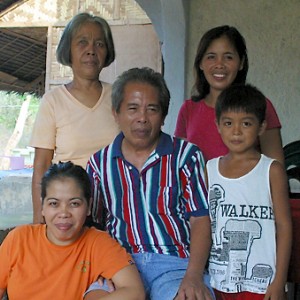It’s unclear how many thousands of people lost their lives in the typhoon that hit the Philippines. But Bethel’s small Filipino population has been desperately trying to reach family back home to make sure they’re okay.
The Philippines has over 7,000 tropical islands, a far cry from the arctic tundra of Bethel. But Bethel is where about 30 Filipinos, including Guada Thatcher, call home. She moved to Bethel 13 years ago, and now, the petite woman with long black hair sits clutching a tissue as she talks about her father who died in the storm.

“My brother messaged me on Facebook and said that I need to call him right away,” Thatcher says. “And then I called him and find out that he was dead. I was like maybe they got the wrong person, maybe it wasn’t him.”
Her uncle confirmed it was her father. He lived on Bantayun Island where his house collapsed on him. The low-lying island is known for its white-sand beaches, clear water and abundant fish but likely hundreds have perished there. Nearly all of the island’s homes were destroyed.
Thatcher has wanted to make funeral arrangements for her father but there’s no infrastructure. She’s left with this thought:
“He died a hero though,” Thatcher says. “He saved his wife, my step-mom’s life.”
Thatcher’s other family lives in Cebu Province and survived the storm with only damages to their property.
“It’s hard, it’s hard to call them, especially the signal over there,” Thatcher says. “So it’s very hard to keep in touch with your family back home.”
Poor communication had Carmie Lautenschlager on pins and needles throughout the storm.
“I keep on trying to call like every minute for two days I keep on trying to call and then…I didn’t talk to anybody that’s why I keep on crying, what happened to them, you know,” Lautenschlager says.
She has been in Bethel less than a year. Her family lives in Leyte, neighboring Tacloban which was hit with 200 mile per hour winds. Her family’s home lost its roof but Lautenschlager counts herself lucky.
“It’s fine,” Lautenschlager says. “The house can be fixed.”
Her real worry is that her parents might not be able to survive without power.
“They said the electricity there is going to be back in six months,” Lautenschlager says. “So I don’t know how… I told my parents if they can’t, if they can’t survive, I’m going to send them to Manila, I think.”
Manila is a large city further from the devastation.
A few hundreds miles south, in Cebu Province, Glenda Swope’s family survived the high winds. Swope has lived in Bethel for nine years. Although she was able to keep in contact with her family by telephone during the storm she had trouble sleeping at night.
“I was terrified,” Swope says. “I was so terrified and I was crying too.”
She knew the storm was bad. She could hear it for herself.
“Because my sister put the phone out, she put it outside,” Swope says. “It sounded like a jet. Like a jet that is going to, you know, explode.”
Swope is counting her blessings. She says the worst of the storm hit during the day and at low tide. Her parents planned ahead covering their windows with plywood and their roof with sand bags.
But not everyone could afford to be so lucky.
There is a lot of poverty in the Philippines with people living under grass roofs and some just out on the street, says Swope. And there’s over crowding, like in Lapu-Lapu City, her hometown.
“The size is comparable to Bethel,” Swope says. “The population is almost 300,000.”
Bethel has just over 6,000 residents.
Swope and others in the tight-knit Bethel community continue to worry about the victims getting the food and water they need. They’re not sure that the emergency goods are being distributed fairly. But they plan to do what little they can right now. They intend to hold a fund raising garage sale this weekend with profits going to the victims.
Here’s the flyer for the fundraiser.




